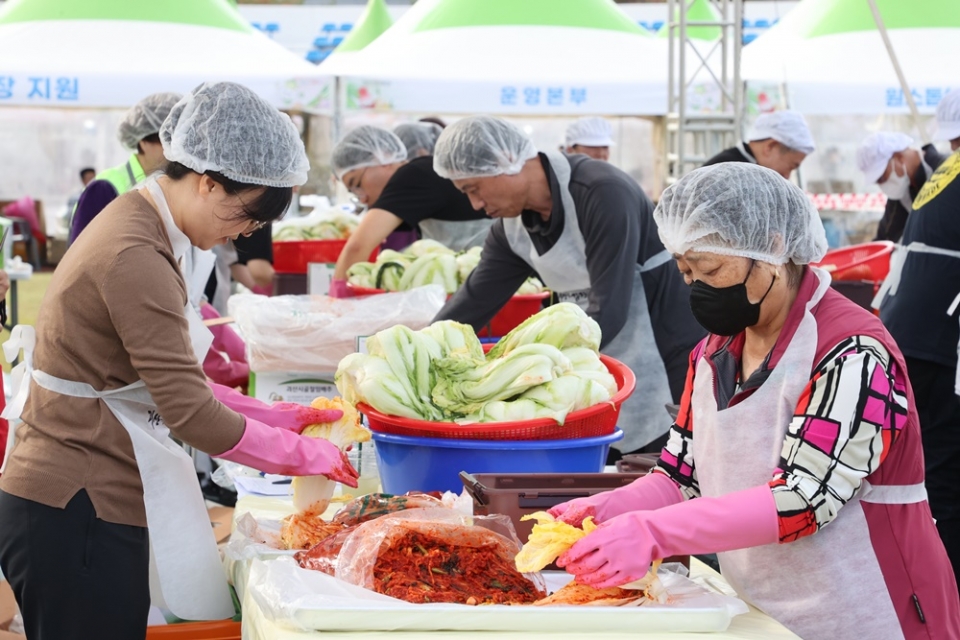
The annual process and culture of making a large volume of kimchi for winter in Korea is called kimjang. This tradition takes place from late fall to early winter, when cold winds begin to blow to facilitate the spicy condiment's fermentation.
I tried my hand at making kimchi on Nov. 3 through a "one-stop kimjang" program at the Goesan Kimjang Festival in Goesan-gun County, Chungcheongbuk-do Province, a two-hour drive from Seoul.
I arrived at Goesan Sports Complex Stadium at 1:50 p.m. when the event began. I received a sanitary cap, apron and rubber gloves to prepare to make kimchi. The kimchi interactive venue's three sections each had about 15 tables where two to three participants, mostly families, made kimchi under staff guidance.
"Kimjang is a very difficult process hard to do alone, so there is a culture of sharing the work with families and neighbors as well as the kimchi made," Gweon Jeong-hee, a guide who gave an explanation of the program, said. "Every year, I send the kimchi I make to my second son, who often goes to France for work."
Kimjang requires the pickling of cabbage in salt and draining afterwards. On this day, we received cabbage in half and salted, so we only needed to spread it on colanders and de-moisturize it. Next, we cut a slit halfway down the base of each cabbage to allow the seasoning to better penetrate it.

Kimjang requires the pickling of cabbage in salt and draining afterwards. On this day, we received cabbage in half and salted, so we only needed to spread it on colanders and de-moisturize it. Next, we cut a slit halfway down the base of each cabbage to allow the seasoning to better penetrate it.
Seasonings came prepared under this one-stop kimjang program including chili powder, salted seafood, chives, mustard leaf, garlic, radish and sesame seeds.
Gweon said, "If you want cool and sweet kimchi, grind a pear in a blender and add it to the kimchi."
Kimchi making began once all the ingredients were prepared. We pulled a head of desalinated cabbage from a colander, started with the smallest leaf and began smearing seasoning evenly on each leaf one by one.
Gweon said, "Kimchi tastes good if seasonings are generously applied to the bottom of the thick cabbage and a little to the edges of thin cabbage leaves."
I tasted the kimchi in between the kimjang process. Kimjang kimchi is eaten over a long period of time, thus it has more salt than regular kimchi and a stronger salty taste.
On how to adjust the salty taste, Gweon smiled and said, "It's a skill acquired only through experience," adding, "The more kimjang you've done, the more you know how to make it with different tastes."
After evenly applying the seasoning on the leaves, wrap it with the longest green leaves and pile them one by one in the container. Once the container is full, cover the kimchi with plastic, remove the air and close the lid.

On what is most important in kimjang, Gweon said, "Putting kimchi you made in a container and preserving it in a kimchi refrigerator."
"The delicious taste of kimchi can be preserved for a long time if the optimal temperature for fermentation is consistently maintained," she added. "Lactic acid bacteria forms during fermentation and becomes nutritious food."
Kim Sang-hwan, who made 20 kg of kimchi that day with his family, said, "We moved here last year and stumbled on the festival by chance. The kimchi we made was so refined and tasty that we came again this year."
"We just don't make our own kimchi here, but also go where our relatives live and make it with them."
Seo Yu-jung, who made kimchi with her husband at the festival, said, "My in-laws live in Goesan-gun so I've been eating kimchi from this region," adding, "I love the taste of the cabbage and chili powder here because it's refined and lighter than kimchi from other regions."
Making 10 kg of kimchi took about an hour because all the ingredients were prepared ahead of time to eliminate the preparation process.
This month, the Pyeongchang Highland Kimjang Festival runs through Nov. 12 in Pyeongchang-gun County, Gangwon-do Province, and the Jeonju Kimjang Culture Festival runs from Nov. 24-25 in Jeonju, Jeollabuk-do Province. For those who think kimjang is complicated and difficult, attending a festival like these is highly recommended.


